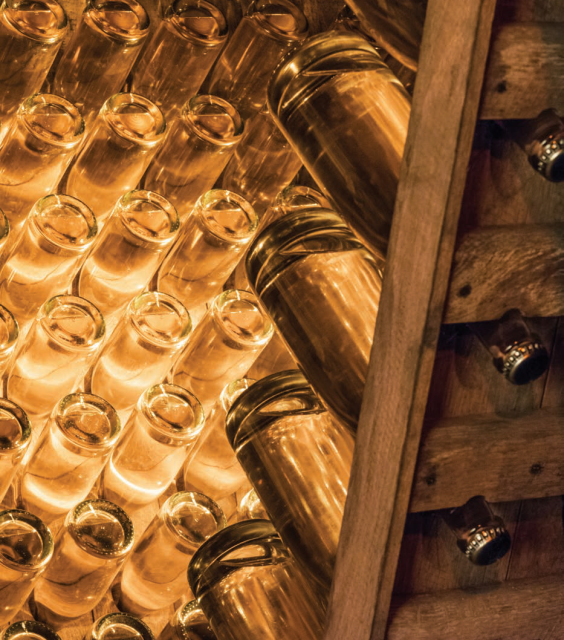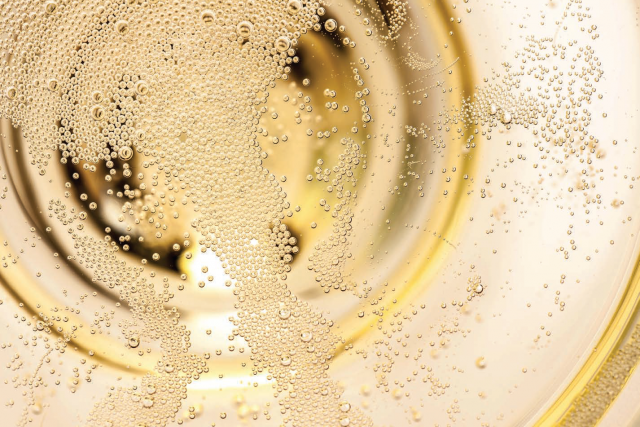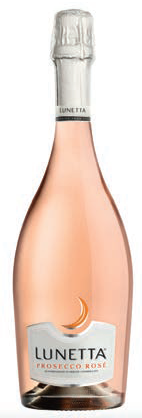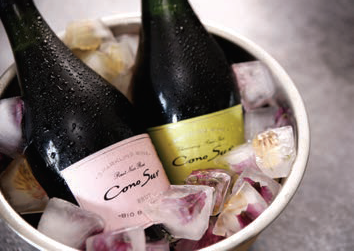In focus: how sparkling wine has fared during the pandemic
By Patrick SchmittGiven that sparkling wines are often thought of as celebratory drinks, 2020, the year of Covid-19, was a tough time. Here, Patrick Schmitt MW looks at the sector, and finds reasons for optimism this year.

During a period when there’s been more cause to moan than celebrate, it’s no shock to learn that sparkling wine, the drink of fun times, has suffered in 2020. But, in a development that may be surprising, the sales drop for fizz in the Covid-19 era has been far from dramatic, and certainly a lot less than feared. Not only that, but it’s believed that sparkling wine will be the fastest sector to recover, as the world’s collective mood improves.
That prediction came from Daniel Mettyear, research director at IWSR Drinks Market Analysis – the collector of global drinks data that regularly gives out forecasts. Based on the sales trends, he expects sparkling wine to recover in full by 2023. Not only does he observe that “a lot of the markets are performing much better than we thought initially”, referring to the early stages of the pandemic almost exactly 12 months ago, but also that the bounce-back for fizz will be faster than for any still wines. “We are looking at a much longer recovery horizon for still wine; the return to growth will be quicker for sparkling,” he says. “Prosecco will be instrumental in that”.
In terms of the proportion of sparkling to still wine sales worldwide, there’s expected to be an almost twofold increase over a 10-year period, with Mettyear telling the drinks business: “The volume share of sparkling wine globally in 2014 was around 10%, but by 2024 we expect that to be 18%, so a big increase.” This, Mettyear believes, will be largely driven by growth in the US – where he predicts that Prosecco sales will overtake those in its domestic market of Italy by the end of 2022 or early 2023.
“Such is the strength of the sparkling wine trend, which is driven in a large part by Prosecco, that sparkling will recover faster than still wine, because there is a buzz about it; it’s about a lifestyle, it’s an Instagram thing, and now there’s rosé Prosecco too,” he says.
“Covid is just a pause in that situation,” he adds, referring to the current slowdown in sales, but notes that it had not been a severe setback, mainly because Prosecco – the dominant force in the fizz market – is not drunk for celebration, but consumed “casually”.
But, before we consider the key sparkling wine categories, what has been the effect on sales because of the pandemic? Overall, according to the IWSR’s estimates, the market has declined by 8%. In terms of cases lost, that represents a drop of around 22 million cases, with the global sparkling wine market in 2019 accounting for 262m cases, and 2020 expected to finish at 240m. Bearing in mind that a year ago declines of 20% to 30% were being mooted, the sparkling wine market has proved remarkably resilient during an extended period with almost no large events, limited social mixing, and a mostly shuttered hospitality sector. In other words, people are not going to stop drinking sparkling wine just because there’s a restriction on socialising. However, the number of bottles consumed at home won’t make up for the lost trade via festivals, weddings, and going out with friends.
CHAMPAGNE
If ever there were a brilliant barometer of collective consumer sentiment, it’s sales of Champagne, which are up when times are good and down when they’re not, with the famous French fizz even believed to act as a signal of a change in fortunes – demand for this sparkling often moves before other indicators of societal health, most obviously economic ones such as GDP. With this in mind, it was expected that Champagne sales would fall, and dramatically so, as Covid-19 reached Europe and the US, precipitating restrictions on basic human freedoms, such as going out and seeing friends and family. With an almost constant barrage of bad news emanating from every media outlet, not only was there no cause for celebration, but plenty of reasons to be fearful. Champagne sales were bound to be hit hard.
And, for those who responded to the Covid-related news in a calm manner, either because they weren’t vulnerable to its impact in terms of health or its economic implications, it would have been difficult to buy Champagne anyway. During the first lockdown, online delivery slots were hard to get, and those essential retailers such as supermarkets used their shelf space for key foodstuffs, not luxuries like Champagne. It’s why there was such a sudden drop in Champagne shipments around this time last year, with declines of up to 70% year on year around April. By the summer, it was predicted that the region would suffer a drop in year-end sales of around 30% – representing 100 million bottles of lost business. This was at a point when people were predicting a return to unrestricted living for the rest of the year.
As we know now, the lessening or total removal of restrictions was short-lived. But we haven’t seen the predicted declines – Champagne has been strangely resilient. During the summer of 2020, when the on-trade opened up, consumption was high value and high volume, then, over the festive period, when the majority of Champagne’s key markets – bar Australia – were once more facing restrictions on going out, people continued to drink the top-end sparkling, even trading up to luxury brands for their stay-at-home Christmases. Another fillip to the sector came in the form of gifting, with a surge of sales recorded by online retailers, as people sent their close friends and family fine Champagnes by courier, with messages of love and hope.
While a year-end surge in Champagne sales via retail, particularly e-commerce operations, provided a vital boost to the sector, it was not enough to make up for the lost business of early 2020, nor that which would have gone through the hospitality sector during its busiest weeks – pretty much all Christmas parties were cancelled. By the end of January, it was official: Champagne was able to report on the extent of the declines, revealing a drop in shipments for the whole of 2020 by 18%, representing a decrease of 52.5m bottles compared with 2019’s total of 297.5m. With last year’s total being 245 million bottles shipped, it had reached a new low for the century so far.
While the size of the decline was lower than feared at the start of the pandemic, the scale of lost turnover is huge: with the value decrease similar to that in volume, Champagne, a €5 billion (£4.26bn) business in 2019, had seen €1bn worth of sales wiped out in 2020. Nevertheless, having shipped around €4 billion worth of Champagne in 2020, it is still a significantly larger market by value than Prosecco’s, which, before Covid, at its peak, was shipping around €2.5 billion worth of fizz worldwide.
When will Champagne recover its lost business? In 2019, it was already a reduced sector in terms of volume – a result of a decline in the discount-driven bottom end of the market in Europe, above all France – but, nevertheless, Champagne’s return to its pre-Covid performance may take a little longer than for Prosecco – at least that’s Mettyear’s feeling. He says: “Opulence and ceremony has been the cornerstone of Champagne’s success, but that has worked against it during the pandemic, when it was bad to be seen celebrating, so it’s a category that’s been hit very hard. But we expect to see some steady growth going forward, returning to 2019 levels in 2023 and 2024.” With this falling behind the full recovery of Prosecco by around a year, in Mettyear’s view, he says the issue for Champagne is related to the economic fall-out from the pandemic, which will last for several years, and could delay a full recovery for this luxury fizz in many of its key markets.

PROSECCO
As for Prosecco, sales during the pandemic have been uneven, with this popular Italian fizz actually enjoying some growth in key markets during 2020, along with more expected declines in others. In essence, such is the strength of Prosecco demand, not even Covid-19 could dent it too badly. Indeed, as a drink more closely associated with casual drinking, rather than celebrations, it took less of a hit in the first half of last year, when, in contrast, Champagne sales plummeted, despite later recovering. As Mettyear observes: “Prosecco has been the engine of sparkling wine growth of the past decade because it’s got an accessible taste and an accessible price.
“This has helped move sparkling wine consumption from being a one-off celebratory drink to something more casual – be it brunch in the United States, or early evening in Australia or the UK.”
Nevertheless, the latter market has suffered a decline, and while it is only around 7% for 2020, because it’s Prosecco’s largest export market, that represents a drop of around 7m bottles. But Mettyear believes part of this is because the Prosecco market in the UK had already peaked. “It is still a category performing well, but it has probably reached its zenith in the UK,” he says.
Although the region has yet to release year-end figures for 2020, the results to September show impressive levels of growth in all the major Prosecco markets (double-digit rises for France, Switzerland, Belgium, Sweden, Poland and Austria, and single-digit for Germany), although the US, accounting for more than 20% of shipments, and the second-largest export market after the UK, has seen a 5% decrease. Mettyear, however, sees the US market as being the future source of growth, and soon. He expects American consumers to take the global Prosecco category to new heights, outstripping its largest market, the domestic one, with further Prosecco growth helped by rising sales in lots of smaller markets.
While Prosecco has benefitted during the pandemic by being an everyday, affordable, light, refreshing drink, rather than something for special occasions, it has also been helped by the launch of a rosé variant towards the end of last year. Pink Prosecco hit the shelves of major retailers from November, boosting the sector, even though initial production volumes were small. There were just 16.8m of bottles of Prosecco DOC rosé produced in time for the launch, rising to around 40m-50m by the end of last year (around 8% of the total production in the region). However, the DOC predicts that Prosecco rosé could reach 90m-140m bottles in production in the near future – taking it to its limits.
With the pink variant, and a popular positioning, Prosecco has been key to the fortunes of the overall sparkling wine market. Looking at pre- and post-pandemic trends, Mettyear explains the importance of the Italian wine for the sector. “After a minor blip linked to the instability created by 2017’s short harvest, sparkling wine resumed its long-term trajectory in 2019 with positive volume and value growth,” he says. “Sparkling wine’s global rise has been driven by its steady transformation from a one-dimensional, big-occasion staple, towards a more summery, casual, and versatile drink that works from brunch right the way through to the early evening; Prosecco has been at the forefront of this change.”
Not only has Prosecco limited the extent of sparkling wine declines during the past year but it will accelerate its recovery too. He says: “Sparkling wine is expected to bounce back fast, making a full recovery as early as 2023 – this will be led by Prosecco’s continued ability to challenge preconceptions of occasion and functionality in the sparkling category.”
Nevertheless, as noted above, Prosecco is a primarily a volume driver, and while its near-600m bottle production (DOC and DOCGs) is now double that of Champagne, when the two categories are looked at in terms of turnover – the picture is reversed: Champagne’s peak turnover was €5 billion in 2019, when Prosecco’s totalled around €2.5bn.
Partner Content

CAVA
So what of the sparkling wine world’s third major brand: Cava? According to the president of the DO Cava regulatory board, Javier Pagés Font, similar to other sparkling wine categories, the Spanish fizz seems to have fared better than expected – when compared with a forecast severe fall-off in demand earlier on in 2020. According to Pagés, shipments to foreign Cava markets were down by almost 8% to 152m bottles, reflecting 71% of the product’s total sales. He even notes growth in some key Cava markets, including the United Kingdom, along with Sweden, the Netherlands, Finland, Russia and Lithuania.
However, Cava did suffer significantly in its home market, where shipments were down by 25% to a little over 63m bottles, accounting for more than two thirds of Cava’s approximate 33m bottle decline during 2020. The reason for this relates to the strength of the on-premise market for all drinks in Spain – unlike markets such as the UK, most of the Cava drunk in Spain is consumed in bars and restaurants. And, with these shuttered or restricted in terms of trading in the country for large parts of last year, the effect on total Cava sales was high. Overall, the region was down by almost 14%, with total shipments amounting to 215.6m bottles, the lowest level for a decade, and some way from the region’s peak output in 2017, when it shipped more than 250,000 bottles.
As for a recovery, Mettyear believes Cava’s road back to better times will take a bit longer than for Prosecco. “While we do expect a recovery, we don’t think Cava will reach 2019 levels for five years,” he says. “Prosecco has a hand in that,” he adds, suggesting that consumers are choosing the Italian fizz over the Spanish one, pointing out that the taste profile and brand are not as appealing to many as Prosecco. As a result, he believes that Cava is an “undervalued category”, although he notes that the regional body “is working hard to address this issue” – with new higher-quality categories, stricter quality controls, and fresh areas of more premium producer-driven growth, such as organic Cavas.

AND FINALLY…
In terms of other sparkling wine sources, there is one notable area that’s “one to watch” for Mettyear. Indeed, it’s one that we have regularly plugged for its high quality-to-price ratio, as seen in the excellent scores at relatively low prices for these styles in our Global Sparkling Wine Masters. These are the crémants from France, with, in our view, two regions offering particular appeal: the Loire and Bourgogne – although Jura is another area of interest within the category. Mettyear says: “We have been seeing consistent growth for crémant, particularly in the UK, but also Germany, the US, Belgium and Sweden. It’s the sparkling category [other than the big three] that stands out, but obviously, it’s much smaller.”
Looking back over the past 12 months, sparkling wine has undoubtedly taken a hit, and a harder one than many other drinks categories. That’s for two main reasons, both of which are directly connected to the pandemic. One relates to sparkling wine’s associations with good times, events and celebrations, and the other to the hospitality sector, where a large proportion of sales take place – more than 40% in the case of Champagne.
With a restricted restaurant and bar trade for much of 2020, and events banned, it’s been tough to make up sales elsewhere, and while rising retail sales – although not the high-value travel retail sector – have made up for some of the lost business in the on-premise, this has not been enough to negate the declines, and hence the overall fall-off in total sales for a sector of the market that was enjoying growth.
However, sparkling wine was expected to suffer more in 2020 – and during the start of this year too. It should be taken as testament to the enduring appeal of this sector that it should prove so resilient during such a difficult time.
Perhaps, with the instinctive human desire to socialise restricted during the past 12 months, the pleasure of good sparkling wine has become even more sought-after during lockdown. On the other hand, with an end of year surge in sparkling wine sales in particular, people may have been celebrating the fact there is an end in sight to the pandemic, even if we haven’t reached it yet. In other words, just knowing that Covid-19 will be combatted is a good enough reason to pop the cork – even if you have to toast your friends remotely.
Highlights
- Despite having been hit by the Covid-19 pandemic, Daniel Mettyear of IWSR says that sparkling wines “are performing much better than we thought initially”, referring to the early stages of the pandemic almost exactly 12 months ago, but also that the bounce-back for fizz will be faster than for any still wines.
- Despite Champagne shipments having fallen by up to 70% year on year last April, the sector has been remarkably resilient.
- Prosecco sales have been uneven, with this popular Italian fizz actually enjoying some growth in key markets during 2020, along with more expected declines in others.
- Cava seems to have fared better than expected when compared with a predicted severe fall in demand.
Sparkling wine: sales trends
Sparkling wine sales total estimate for 2020 according to IWSR:
240 million cases (-8% on 2019)
Champagne shipments 2020:
245m bottles (-18% on 2019)
Prosecco DOC shipments 2020:
est. 452m bottles (-7% on 2019)
Cava DO shipments 2020:
215.6m bottles (-14% on 2019)
Brand updates
Barton & Guestier – Patriarche-Liste

Barton & Guestier – PatriarcheListe has launched two sparkling wines: Veuve du Vernay Organic, and Veuve du Vernay Zero, the latter being a dealcoholised sparkling wine with less than 0.5% ABV. The group is also developing an Eiffel Tower display as well as a gift-pack programme to help sales of the sparkling wine in the retail sector. Speaking about the past year, Philippe Marion, sales and marketing director, said that sparkling wine sales at the group fell by 25% in 2020 – mainly due to the closure of the on-trade and also the stopping of cruise lines in its main market, the US.
Asti Spumante
The range of styles legally admitted for Asti DOCG has been extended to include all levels of sugar content, including Brut, Extra Brut or Brut Nature – even though sweet sparkling is still the region’s core business. Following a move in 2017 to allow demi-sec or extra-dry Asti, last year the rules were relaxed to allow drier styles, include sparkling wines with no residual sugar at all. The total 2020 production for the entire area, including Asti DOCG and Moscato d’Asti DOCG was 91.6m bottles, up from 84.5m in 2019, representing an increase of 8.4%. Of this total for 2020, Asti DOCG represented 53.4m bottles, up by 4.3%, and Moscato d’Asti DOCG 38.2%, a rise of 14.7%.
Lunetta

Lunetta has added a Prosecco Rosé Millesimate Extra Dry to its range of sparkling wines. The fizz has been made by blending finished white wine made from Glera with red wine from Pinot Nero. Once blended, the pink wine undergoes second fermentation in sealed temperature-controlled stainless steel tanks to develop its sparkle. The finished fizz is bright pink with flavours of cherry and pear.
Cono Sur

Cono Sur has launched a charmatmethod sparkling rosé using Pinot Noir from the Bío Bío valley in southwest Chile. This sparkling wine comes in addition to the brand’s eight expressions of Pinot Noir, reinforcing Cono Sur’s position as a leading New World Pinot Noir producer. The new pink sparkling uses grapes from Chile’s last winegrowing frontier in Mulchén in the Bío Bío valley, one of the southernmost origins in the world. Cono Sur’s vineyards are planted in red, clayish and mineral soils, without irrigation.
Prosecco DOC
Despite being a disruptive year for the global wine sector, Prosecco DOC wine production reached an all-time high of 500.4 million bottles in 2020. This represented a growth of 2.8% compared with the certified volumes in 2019, which amounted to an increase of around 14 million bottles. The introduction of Prosecco DOC Rosé, with 16.8 million bottles produced in the last months of 2020, has contributed to this positive development.
Gusbourne

Gusbourne has just released its 2016 Blanc de Blancs English sparkling wine. Other than some magnums, the company is holding back on new-release sparkling expressions until the next vintage of its Brut Reserve and Rosé – both 2017s – which will be released at some point in the later summer. The producer also plans to release the next vintages of its still wines soon. Its Pinot Noir Rosé 2020 is only available to those consumers who are in its membership club currently, but will be on sale to the wider public from 1 April, followed by the Pinot Noir 2019 on 1 May, and Chardonnay Guinevere as well as Chardonnay 809 2019 on 1 June. All are available to members first, before a wider release online and at the Nest – the cellar door – if stocks remain.




